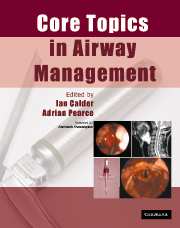Book contents
- Frontmatter
- Contents
- List of contributors
- Preface
- Acknowledgements
- List of abbreviations
- 1 Anatomy
- 2 Physiology of apnoea and hypoxia
- 3 Physics and physiology
- 4 Cleaning and disinfection of airway equipment
- 5 General principles
- 6 Maintenance of the airway during anaesthesia: supra-glottic devices
- 7 Tracheal tubes
- 8 Tracheal intubation of the adult patient
- 9 Confirmation of tracheal intubation
- 10 Extubation
- 11 Light-guided intubation: the trachlight
- 12 Fibreoptic intubation
- 13 Retrograde intubation
- 14 Endobronchial and double-lumen tubes, bronchial blockers
- 15 ‘Difficult airways’: causation and prediction
- 16 The paediatric airway
- 17 Obstructive sleep apnoea and anaesthesia
- 18 The airway in cervical trauma
- 19 The airway in cervical spine disease and surgery
- 20 The aspiration problem
- 21 The lost airway
- 22 Trauma to the airway
- 23 Airway mortality associated with anaesthesia and medico-legal aspects
- 24 ENT and maxillofacial surgery
- 25 Airway management in the ICU
- 26 The airway in obstetrics
- Index
11 - Light-guided intubation: the trachlight
Published online by Cambridge University Press: 15 December 2009
- Frontmatter
- Contents
- List of contributors
- Preface
- Acknowledgements
- List of abbreviations
- 1 Anatomy
- 2 Physiology of apnoea and hypoxia
- 3 Physics and physiology
- 4 Cleaning and disinfection of airway equipment
- 5 General principles
- 6 Maintenance of the airway during anaesthesia: supra-glottic devices
- 7 Tracheal tubes
- 8 Tracheal intubation of the adult patient
- 9 Confirmation of tracheal intubation
- 10 Extubation
- 11 Light-guided intubation: the trachlight
- 12 Fibreoptic intubation
- 13 Retrograde intubation
- 14 Endobronchial and double-lumen tubes, bronchial blockers
- 15 ‘Difficult airways’: causation and prediction
- 16 The paediatric airway
- 17 Obstructive sleep apnoea and anaesthesia
- 18 The airway in cervical trauma
- 19 The airway in cervical spine disease and surgery
- 20 The aspiration problem
- 21 The lost airway
- 22 Trauma to the airway
- 23 Airway mortality associated with anaesthesia and medico-legal aspects
- 24 ENT and maxillofacial surgery
- 25 Airway management in the ICU
- 26 The airway in obstetrics
- Index
Summary
Light-guided intubation was introduced in 1959 by Yamamura. Since then several intubation devices which use transillumination have been developed. In 1995 Hung introduced the Trachlight, which has proved to be the most popular device. This instrument has been thoroughly evaluated in almost 50 published articles and has been proven to be safe, effective and easy to use in most cases.
Principle of transillumination
The light-guided intubation technique is based on transillumination of the soft tissues of the neck from inside out. A lighted stylet is placed in the endotracheal tube (ET) in such a way that the light source marks the tip of the ET. ET and stylet are introduced into the upper airway and transillumination indicates the position of the tip of the ET in the patient. When transillumination is seen externally at the level of the cricothyroid membrane, the tip of the ET is considered to be distal to the vocal cords, in the larynx. When the ET is further advanced into the trachea, the tip can be followed by means of a moving transilluminated spot.
Instrument
The Trachlight consists of three parts: a handle, a semi-rigid pliable metal stylet and a hollow flexible lightwand (Figure 11.1). The stylet fits inside the hollow lightwand and the ET is mounted over the lightwand. When the stylet is clicked into the active position, the combination of both components plus the ET is semi-rigid but pliable. During the process of intubation the stylet can be retracted out of the lightwand which turns the lightwand flexible again. This is important because the rigidity facilitates manoeuvring the lightwand through the vocal cords into the larynx, while the flexibility enables safe advancement of the ET further into the trachea.
- Type
- Chapter
- Information
- Core Topics in Airway Management , pp. 93 - 96Publisher: Cambridge University PressPrint publication year: 2005



